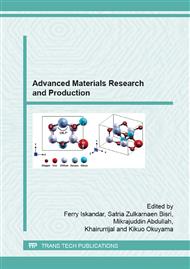p.85
p.89
p.94
p.98
p.102
p.106
p.110
p.116
p.120
Modeling of Electron Tunneling Current in a p-n Junction Based on Strained Armchair Graphene Nanoribbons with Extended Tight Binding and Transfer Matrix Method
Abstract:
A theoretical model of electron tunneling current in a p-n junction based on strained armchair graphenenanoribbons (AGNRs) is developed. The effects of strain to the energy dispersion relation and the band gap of AGNR are formulated under the extended tight binding method. The electron transmittance was derived by utilizing the transfer matrix method. The calculated transmittance was then used to obtain the tunneling current by employing the Landauer formula with Gauss Quadrature computation method. The effects of strain to the energy band gap, AGNR width, and tunneling current are studied thoroughly.
Info:
Periodical:
Pages:
102-105
Citation:
Online since:
July 2015
Keywords:
Price:
Сopyright:
© 2015 Trans Tech Publications Ltd. All Rights Reserved
Share:
Citation:


